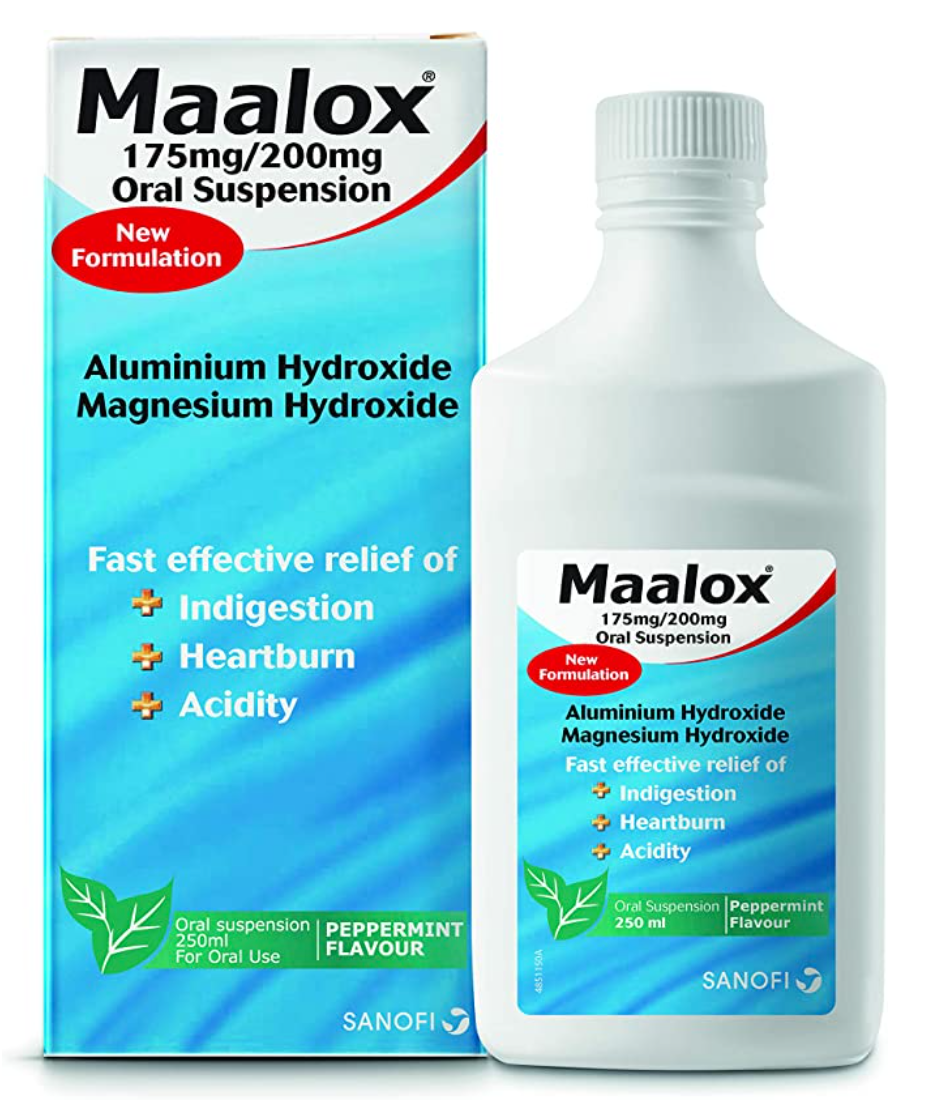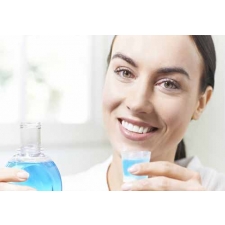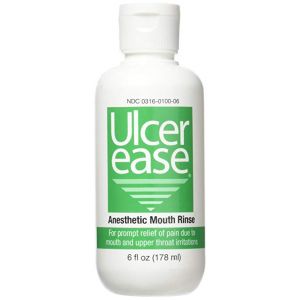Many patients undergoing chemotherapy or other cancer treatments develop oral mucositis, or mouth sores. Sometimes doctors will prescribe a “magic mouthwash” to treat these sores . Doctors will send the ingredients they recommend to a compound pharmacy. Though there is no standardized formula for magic mouthwashes, each typically contains at least three different ingredients to reduce pain and swelling in the mouth. Some of the properties of the Magic Mouthwashes can be achieved in over-the-counter products listed in #6 below.

Painkillers
Magic mouthwashes usually contain an antihistamine or a local anesthetic to reduce pain.1 A commonly used anesthetic is lidocaine, which is frequently used as a topical numbing agent. This is the anesthetic that dentists use when they numb your teeth and gums for dental procedures. It works by blocking sodium channels in neurons in the area.2-4
The antihistamine diphenhydramine (brand name Benadryl) is sometimes also included. It is an anticholinergic drug, which inhibits the neurotransmitter acetylcholine. You’re probably familiar with diphenhydramine as a treatment for allergies and hives, but it also has local anesthetic properties.2-4

Antibiotics
Infection is a significant risk that comes with oral mucositis. Bacterial colonization in these wounds can increase pain and inflammation and make the sores more difficult to heal.5 Magic mouthwash recipes often include an antibiotic to prevent the growth of harmful bacteria.1 Tetracycline is a common antibiotic frequently used in magic mouthwash formulations. Chlorhexidine is sometimes also used, which is an antiseptic used in prescription mouthwashes for cavity protection and bad breath (halitosis).6

Antifungals
Like bacteria, yeast and fungi can proliferate in mouth sores and in mouths impacted by pH changes or medications that affect the immune system. This is why you can develop thrush when using inhalers regularly or taking other oral medications. Antifungals are sometimes included in magic mouthwash mixes to prevent yeast and fungi from growing.1 Nystatin (brand name Mycostatin) is often the antifungal of choice for magic mouthwashes.6

Corticosteroids
Mouth ulcers develop as a result of inflammation in the mouth, caused directly by chemotherapy drugs or from radiation therapy in the head and neck areas. Controlling inflammation is key to helping these sores heal, and for reducing the pain and discomfort associated with them. Magic mouthwashes often include corticosteroids to reduce inflammation in the surface tissues in the mouth.6 Corticosteroids are a type of hormone that regulates the activity of immune cells, and when used topically can reduce inflammatory signaling in the cells just under the surface of your skin.

Antacids
Antacids are typically used to reduce acidity in your stomach and digestive track. Their chemical properties also make them useful for coating the lining of your mouth, making sure that other active ingredients in a mouthwash stick to your gums and the inside of your cheeks and lips. One such antacid frequently used in magic mouthwashes is an aluminum hydroxide/magnesium hydroxide mix (brand name Maalox), sometimes in combination with simethicone (brand name Mylanta). Other viscous substances sometimes are used for the same purpose of coating, including sucralfate, gelatin, pectin, carboxymethyl cellulose (a type of starch), polythene, and liquid paraffin.6


Top Recommended Magic Mouthwashes (non-prescription)
These OTC mouthwashes have some of the properties listed above including numbing (Ulcer Ease), antibacterial, antifungal and soothing of irritations. Many users have found relief from these brands. Read the descriptions of each to see which one is best for you.
[1] Moynihan TJ, Mayo Clinic. Magic mouthwash: Effective for chemotherapy mouth sores?” “Mayo Foundation for Medical Education and Research. FAQ-20058071. https://www.mayoclinic.org/tests-procedures/chemotherapy/expert-answers/magic-mouthwash/faq-20058071
[2] Dodd MJ, Dibble SL, Miaskowski C, MacPhail L, Greenspan D, Paul SM, Shiba G, Larson P. 2000. “Randomized clinical trial of the effectiveness of 3 commonly used mouthwashes to treat chemotherapy-induced mucositis.” Oral Surg Oral Med Oral Pathol Oral Radiol Endod. Jul; 90(1):39-47. https://www.ncbi.nlm.nih.gov/pubmed/10884634?dopt=Abstract
[3] Sarvizadeh M, Hemati S, Meidani M, Ashouri M, Roayaei M, Shahsanai A. 2015. “Morphine mouthwash for the management of oral mucositis in patients with head and neck cancer.” Adv Biomed Res. 4:44. https://www.ncbi.nlm.nih.gov/pmc/articles/PMC4358035/
[4] Kirk LM, Brown SD, Luu Y, Ogle A, Huffman J, Lewis PO. 2017. “Beyond-use dating of lidocaine alone and in two ‘magic mouthwash’ preparations.” Am J Health Syst Pharm. May 1; 74(9):e202-e210. https://www.ncbi.nlm.nih.gov/pubmed/28438825
[5] Rubenstein EB, Peterson DE, Schubert M, Keefe D, McGuire D, Epstein J, Elting LS, Fox PC, Cooksley C, Sonis ST. 2004. “Clinical practice guidelines for the prevention and treatment of cancer therapy-induced oral and gastrointestinal mucositis.” Cancer. May 1; 100(9 Suppl):2026-2046.
[6] Chan A, Ignoffo RJ. 2005. “Survey of topical oral solutions for the treatment of chemo-induced oral mucositis.” J Oncol Pharm Practice. 11:139-143. http://journals.sagepub.com/doi/pdf/10.1191/1078155205jp166oa?casa_token=wNleTKZREy4AAAAA:N_KQhdKx21uPq6oswJNQQjetnXrdiBt3eSOxS1Ex7V6nSZgs2zQ7v2BbrW3wn5uYRgTui0G0abYpEg
Search the blog
Article Categories
- All Articles (95)
- Rating Charts (1)
- Beauty & Skincare (17)
- FAQ (0)
- Hair Care (9)
- Health & Wellness (12)
- Anti-Aging (4)
- Kid's Health (0)
- Makeup (2)
- Men's Health (2)
- Oral Care (3)
- Sunscreen (7)
- Skin Tools & Treatments (10)
- Supplements (26)
- Videos (0)







